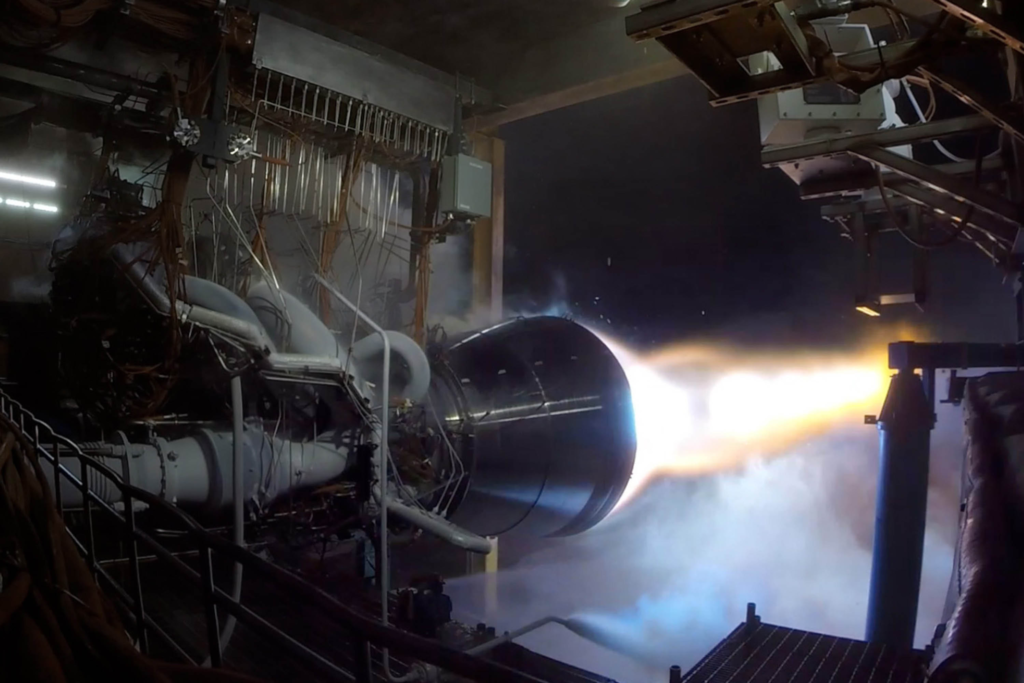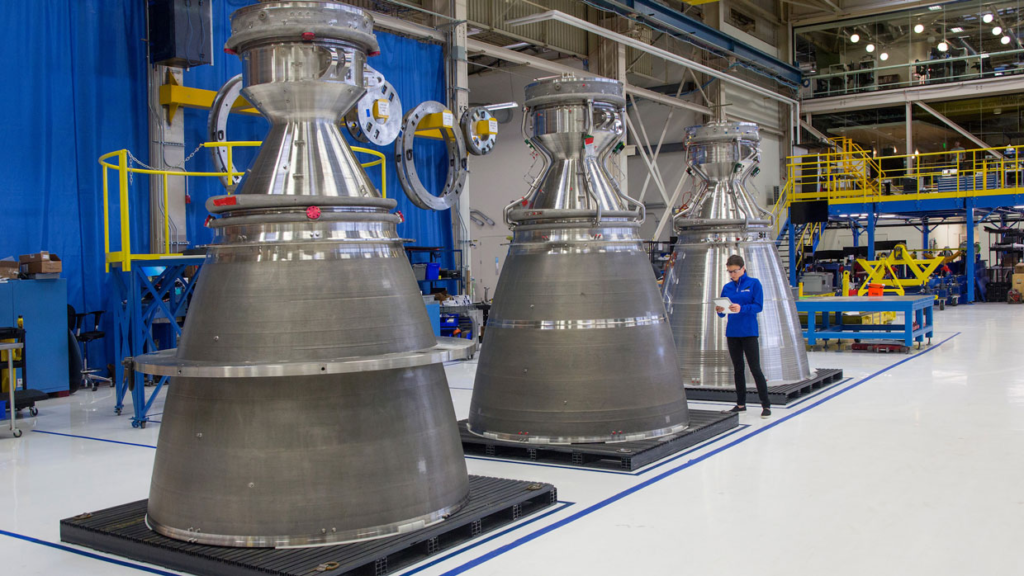
What Is The Progress On Blue Origin’s BE-4 Engines?
Throughout the space industry, we are watching a large group of companies and agencies work on next generation launch vehicles. These rockets feature ambitious engineering and unique plans for the future. Blue Origin and United Launch Alliance have both been working on vehicles just like these. At the core of these plans is the engines themselves meant to propel the rocket.
Blue Origin has been developing the BE-4 engine for many years now. During the time period, there have been a lot of ups and downs. Rocket engine development is both a very complex and important process. Over the past few months especially the company has provided some updates on the engine’s progress and what to expect in the near future.
Not only is Blue Origin relying on the success of the BE-4 but also ULA as they continue to make progress on Vulcan. However, due to some delays and complications, there have been concerns regarding the future of the engine. Here I will go more in-depth into some of the recent news on BE-4, the engine itself, and what to expect in the coming months.
Recent Updates

In the last few weeks alone, both Blue Origin and other sources including ULA and Tory Bruno have provided a decent amount of updates on BE-4 and the future of this engine. Specifically, starting in late May, Blue Origin tweeted saying, “Back by popular demand – we’re sharing the video of the rapid throttle up from 40% power level. Our team has extensively tested combustion stability across the entire throttle range and designated mixture ratios.” They followed this with another tweet that mentioned, “Deep-throttling and rapidly-responding rocket engines enable a rocket launch vehicle to land vertically. Here we tested those capabilities for the #BE4, resting at a 40% power level before being commanded back to full power just milliseconds later.” These tweets included footage of the recent BE-4 engine firing.
Next, Tory Bruno, the CEO of United Launch Alliance, tweeted saying, “The flight BE4s are in the assembly stand @blueorigin . Here’s a view from the upper platform of one of the pair with the very cool additively manufactured GOX dome installed.” This included a photo of the engine which was still missing some components but primarily assembled. In addition to the tweet itself, people asked Tory when he expected the engines to be at ULA. He replied with “mid-year” suggesting very soon. On June 16th Blue Origin tweeted again this time pointing out, “In 2016, we developed our #BE4 start sequence and tested initial preburner injector hardware. While we ran 596 seconds of deep throttle over 82 tests, this high-speed camera captured the very first stable element-by-element ignition through its start sequence.” A short video was included highlighting this process and a very unique camera view. Finally, only a few days ago Blue Origin tweeted once again, this time saying, “For the first time, our Huntsville engines team has installed a #BE4 engine into Blue Origin’s refurbished and historic MSFC Test Stand 4670 preparing for commissioning tests.” This tweet showed off multiple close up images of the engine and its position within the test stand.
BE-4 & Its Future

Now that we know more about some of the recent progress and updates on BE-4, we can take a closer look at the engine itself, and also the launch vehicles that will rely on it not long from now. This engine has not had the smoothest development over the past couple of years. Due to a long list of complications and other errors, it has been delayed quite significantly. This was a big concern for launch vehicles such as Vulcan due to its fast progress and need for engines. This being said, in the last few months we have watched the company continue to work on BE-4, and now towards the end of June, Tory Bruno is confident he will receive the engines very soon.
Looking at the engine itself, Blue Origin describes the BE-4 as America’s next rocket engine. This engine is one of the most powerful liquefied natural gas fueled rocket engine ever developed. Using an oxygen-rich staged combustion cycle, BE-4 is capable of producing 2,400 kN (550,000 lbf) thrust with deep throttle capability. In terms of the propellants, Blue Origin choose LNG because it is highly efficient, low cost and widely available. They point out that, unlike kerosene, LNG can be used to self-pressurize its tank. Known as autogenous repressurization, this eliminates the need for costly and complex systems that draw on Earth’s scarce helium reserves. LNG also possesses clean combustion characteristics even at low throttle, simplifying engine reuse compared to kerosene fuels.
BE-4 was designed from the beginning to be a medium-performing version of a high-performance architecture. Blue Origin highlights that it’s a conscious design choice made to lower development risk while meeting performance, schedule and reusability requirements. With our hardware-rich approach, multiple developmental units and redundant test stands enable a high test tempo and rapid learning. The company is currently undergoing full-scale engine development testing at its facilities in Van Horn, Texas. In addition, full rate production will occur in our new engine manufacturing facility in Huntsville, Alabama.
We then have the two launch vehicles that rely on BE-4. As I partially mentioned prior, this includes ULA’s Vulcan Centaur, and Blue Origin’s New Glenn. Starting with Vulcan, which leverages the proven processes, technology and experience of Atlas and Delta, the Vulcan Centaur rocket introduces new technologies and innovative features to create a high value launch service with optimal performance to meet the full range of mission requirements. Vulcan Centaur consists of a single booster stage powered by a pair of BE-4 engines, the high-energy Centaur upper stage powered by two RL10 engines, and a 5.4-meter-diameter payload fairing. For additional power at liftoff, up to six solid rocket boosters can be added to the Vulcan Centaur rocket. By making launch more affordable, Vulcan Centaur opens up new opportunities for space capabilities, offering unprecedented flexibility in a single system. From low-Earth orbit to Pluto, the single-core Vulcan Centaur has many capabilities. One of the reasons the progress of Blue Origin’s BE-4 development has been so important is because of Vulcan. While New Glenn also relies on this engine, the Vulcan Centaur is far ahead and expecting to launch soon. Without engines however, this next generation launch vehicle is going nowhere. About one week ago, when replying to tweets, someone asked Tory Bruno when he was expecting to launch Vulcan based on current progress. The CEO replied this year. Already at the middle of the year, this means only months from now they expect to receive, install, and use multiple BE-4 engines for the first time. This helps put in perspective the time crunch and necessity for Blue Origin to deliver.
Next is New Glenn with a less aggressive schedule. The date of this launch has been pushed back which relieves a lot of pressure on engine development. New Glenn, named after astronaut John Glenn, is a single configuration heavy-lift launch vehicle intended to carry people and payloads routinely to Earth orbit and beyond. It features a reusable first stage built for 25 missions. This reusable booster is intended to make it competitive in a variety of launch markets. The idea is civil, commercial, and national security customers can all find solutions in New Glenn’s high-performance configuration. Blue Origin describes the rocket as a reliable, cost-competitive system with high availability. The 7-meter fairing has two times the payload volume of any existing launch vehicle, which means more room for satellites and the freedom to build in more capacity. New Glenn is also able to launch and land in 95% of weather conditions, making it a reliable option for payload customers. At the very bottom of the rocket, seven reusable and throttleable BE-4 LOX/LNG engines, creating a first stage that generates 17,100 kN (3.85 million lbf) thrust at sea level. Blue Origin also highlights that New Glenn is designed for operational reusability from the beginning. BE-4, the world’s most powerful liquid oxygen / liquefied natural gas engine, is intended to enable New Glenn to launch payloads over 13 metric tons to geostationary transfer orbit and 45 metric tons to low Earth orbit. All of which rely on the continued development and manufacturing of the BE-4 engine.
Conclusion
Over the past few years, Blue Origin has continued to work on the BE-4 engine in preparation for two launch vehicles of the future. In recent months especially, the company along with ULA have provided some updates on the engine’s progress and what to expect. This has helped keep us updated on both Vulcan and New Glenn’s development. As of right now in the middle of the year, Tory Bruno is confident he will be receiving his engines soon as Vulcan continues to make fast progress. We will have to wait and see how it progresses and the impact it has on the space industry.